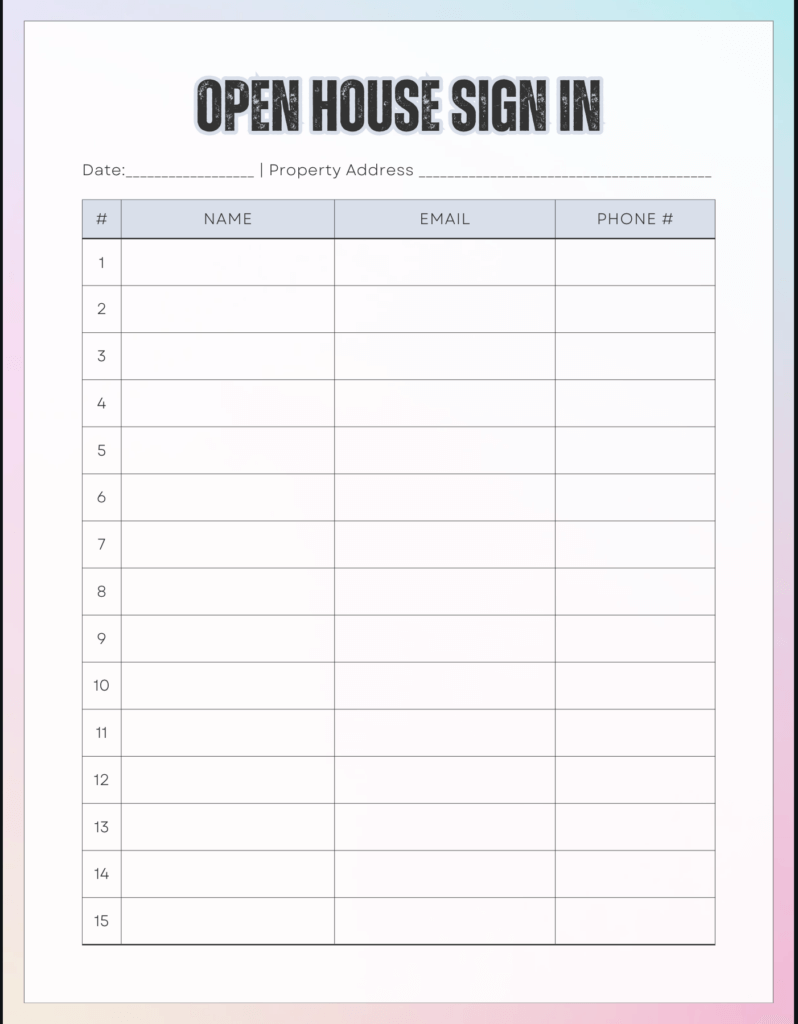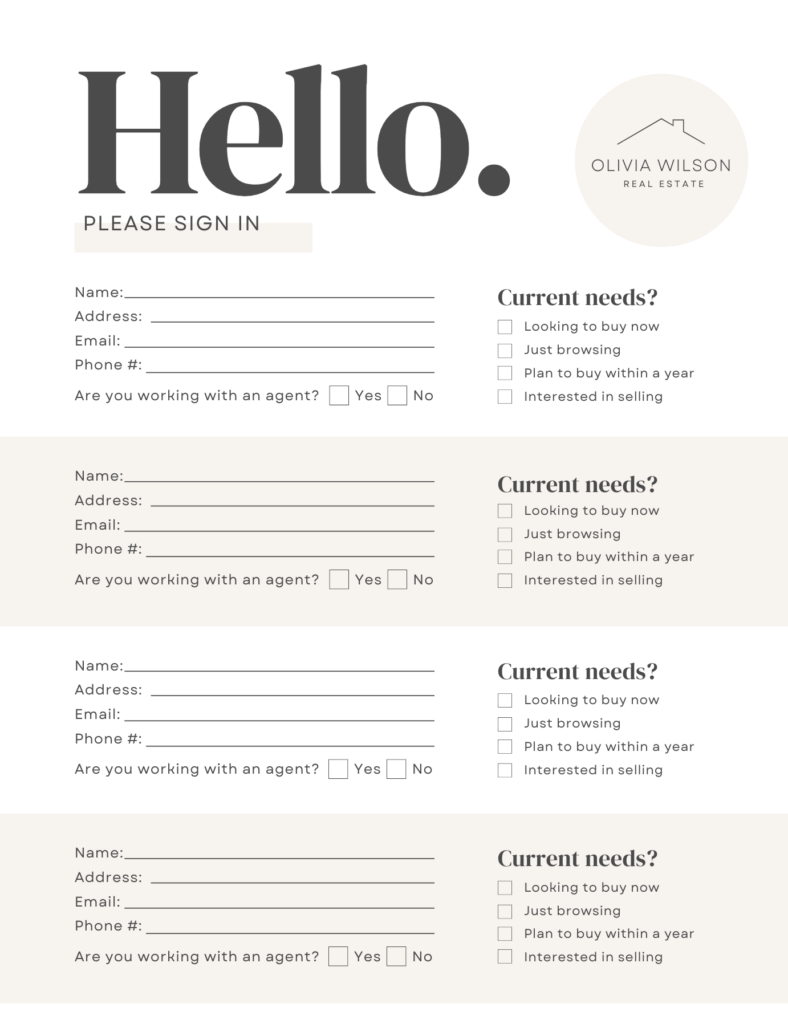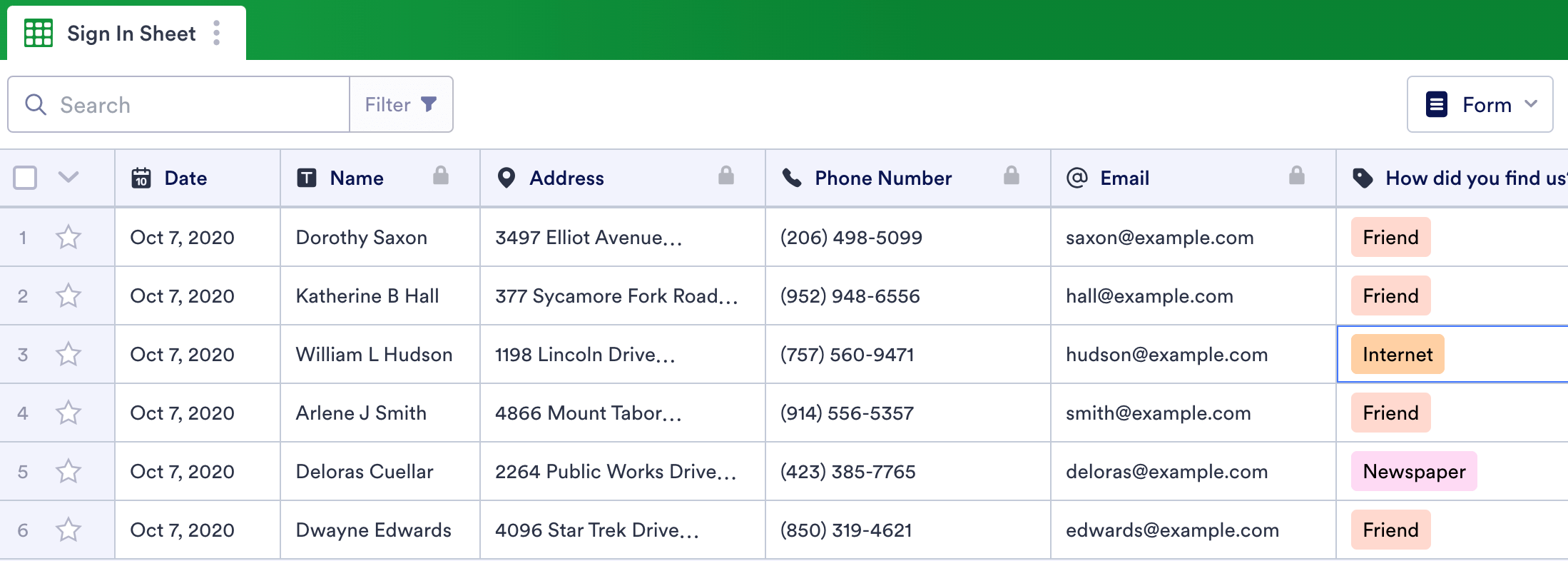Hosting an open house is one of the best ways to… waste your time. But it can also be a highly effective way to capture leads.
What’s the number one way to ensure it’ll be the latter?
Use an effective open house sign-in sheet. If you want to know more about how to do that, you’re in the right place. This article is for you.
What You’ll Learn:
- Tips for creating an effective open house sign-in sheet
- How to create your own (quickly) for free
- Best practices for following up with the leads you generate from your open house
Tips for Creating an Effective Open House Sign-In Sheet
Keep It Simple
Your sign-in sheet should be brief. The longer it is (or appears to be!), the less likely it is that your guests will fill it out.
You’ll always need these essentials:
- Name
- Email address
- Phone number
- Home/Mailing address
If you had only those pieces, you’d have what you need. But some agents prefer to have a little more context to work with. For example…
- You could include one or two close-ended questions that have Likert scale response options. Example: “How interested are you in buying a home in the [your area] area?” (1 being “not at all interested” and 5 being “extremely interested”)
- Ask if they’re interested in a free home valuation.
- Find out if they’re already working with a real estate agent.
- You could ask questions to understand how you can best help them right now in their home buying or selling journey.
- Try to find out where they are in their home-buying and home-selling journey. (Are they homeowners? Are they first-time buyers? How many properties do they have?)
- Or you could include open-ended questions where respondents can write candidly and say whatever they want to say. Examples: “How can I help you?”; “What brings you here today?”; “How did you hear about this open house?”
If you decide to add more fields for your guests to fill out, don’t overdo it! Keep the total to around five. No one wants to feel like they’re applying for a job when they arrive at your open house.
Make It User-Friendly
An open house sign-in sheet can be simple and brief but annoying to fill out. So in addition to making it straightforward, make sure it’ll also be both quick and easy.
You might want to use hardcopy paper sign-in sheets. Here are the pros and cons to consider:
Pros To Using Paper:
- Accessibility – Easy for visitors to use, as most people are familiar with filling out paper forms.
- No technology barriers – Everyone can participate, regardless of their comfort level with technology.
- It’ll always work – No need to worry about technical issues or device malfunctions.
- It’s cost-effective – Paper and pens tend to be more affordable than investing in tablets or electronic systems!
Cons To Using Paper:
- Legibility could be a factor – Handwriting can be difficult to read, which means you might end up spending more time deciphering data and hoping you got it right.
- Data entry might be time-consuming – Manually entering data from paper into a digital system can be time-consuming.
- The experience will be less flashy – Paper forms don’t offer the interactive and dynamic features that electronic systems can provide.Or you might want to use a tablet or some other electronic device. But there are
Pros To Using an Electronic Sign-In:
- It’s more efficient – Your guests will enter their data into a digital system, which both reduces the need for manual transcription and minimizes errors.
- It presents customization opportunities in terms of how you design your questionnaire – For example, you could structure it like an electronic survey so that the questions or fields each visitor receives change based on their responses.
- It could make analytics and reporting easier – Electronic systems often come with built-in analytics tools, providing insights into visitor demographics and preferences.
Cons To Using an Electronic Sign-In:
- The cost – Initial setup costs for tablets or electronic systems can be higher than using paper, of course.
- There might be a learning curve involved – It could take you some time to figure out the best way to make it work. And some visitors may not be familiar or comfortable with electronic sign-ins, which could lead to errors or usability issues.
- Technical Issues – Any time you use electronic devices of any kind, you run the risk of having to deal with technical difficulties. The battery could run low. Or you could encounter software glitches or connectivity problems.
Whichever option you go with, it’s best to prioritize user-friendliness over all else. Because again, if your open house sign-in sheet is easy to fill out, you’ll be more likely to capture leads and all of their (accurate!) information.
Add Your Branding
This is huge. One of the main purposes of hosting an open house is to get your name and brand in front of more potential clients. And your sign-in sheet is among the first things your visitors will encounter.
In a crowded field with many competitors, it’s your brand that makes your real estate business unique in the eyes of your community and sets you apart. (If you need a quick crash course in real estate agent branding, this is the best guide you’ll find!)
Use your brand colors. Make sure your logo is always front-and-center. (If you don’t have one yet, you can quickly learn how to develop and create effective real estate logo ideas.) And consider including your slogan.
Every time your potential clients engage with your brand, it should be a positive experience. And those positive experiences should lead them toward deeper levels of engagement with your brand. In this case, even something as small as an open house sign-in sheet has the potential to help turn a “visitor” into a client.
Give Them a Reason To Fill Out Your Sign-In Sheet
It’s not as if checking out your open house sign-in sheet is something your guests will want to do for fun. Many people are hesitant to give out their information. And unless they have a clear benefit in their minds that will come as a result of engaging with your sign-in sheet, chances are, they won’t do it.
So make the benefit obvious. Here are some ideas.
- Make it a giveaway – Create a raffle or giveaway and let guests know that by signing in, they automatically enter for a chance to win a prize. This could be a gift card, home decor item, or something related to the local community.
- Promise to provide something of value in return – For example, you could give them a free home valuation coupon, a homebuyer’s guide, a local housing market cheatsheet, or an ebook that covers common questions or a sought-after topic.
- Give them coupons to local businesses – Partner with local businesses to provide coupons or discounts to those who sign in. (As a side benefit for you, this also provides a great real estate networking opportunity.)
- Offer refreshments or snacks – Make it so that everyone who signs in gets something delicious. Of course, this will only work if you offer food or drink that your guests will truly want, so make it good!
3 Awesome Open House Sign-In Sheet Examples
1. The “Meat & Potatoes” Template

What We Love About It:
This open house sign-in sheet from Canva doesn’t mess around. Sure, it’s basic. But you’d have everything you need to follow up with your leads. And you didn’t have to spend hours creating it or overthinking it.
2. The “Warm Welcome” Template

What We Love About It:
With this idea, you’d get what you need (basic contact info), and you’d get some extras (e.g., insight into their current needs). It’s warm and inviting. And this offers a great example of how you can incorporate your brand colors and logo into it. (This also comes from Canva.)
3. The Spreadsheet Idea

What We Love About It:
Jotform has created a great example of digital form you could use as an open house sign-in sheet. After the “Email” column, there are columns that say, “How did you find us,” “Status” (with options like “Rent” or “Own a home”), and “What are your current real estate needs.”
We love that this design allows agents to collect a lot of valuable information about their potential leads without asking too much of their visitors. They can simply click from a list of choices, rather than type in their answer. So in that way, it functions as efficiently as a survey.
How To Create Your Own Open House Sign-In Sheets (Quickly) for Free
There are plenty of free open house sign-in sheet templates out there. But the problem is, they tend to be generic and limited in terms of customization options. That’s a problem because it has the potential to undermine the first three tips listed above.
So whether you create yours from scratch or work with a free template, take the time to “make it yours.” The leads you get in return will make it worth the effort.
Option 1: Use Your Favorite Word Processor (Like Word or Google Docs)
- Step 1: Open a new Word or Google Docs document
- Step 2: Add a header that says something like “Open House Sign-In Sheet,” “Welcome,” or “Guestbook.” Be sure to include your contact information and your logo (along with any other brand elements such as a slogan).
- Step 3: Add text boxes with instructions on why visitors should sign in and any incentives you’re offering.
- Step 4: Create a table where they’ll input their information.
- Step 5: Save the document and print copies for your open house. Or if you prefer a digital sign-in, share the document as a Google Doc or PDF.
Option 2: Use a Free Design Platform
Using design platforms like Canva, Visme, and VistaCreate allows you to leverage customizable open house sign-in sheet templates, intuitive editing features, and a vast library of graphics to effortlessly create professional real estate logos, regardless of your design experience or skill level.
- Canva – This is by far the most popular option for a reason. It’s easy to use and offers more than 250,000 free high-quality templates, including many open house sign-in sheets.
- Visme – Visme is a strong Canva alternative that’s used by 20 million people worldwide.
- VistaCreate – With a mission “to give every human the freedom to create,” VistaCreate is yet another user-friendly tool with more than 10,000 templates and millions of creative assets you can use to create open house sign-in sheets.
Option 3: Create a Digital “Survey”
“Survey” is in quotes because we’re not talking about surveys, in the sense of asking people what they think about your open house. We mean using survey software to create an information-gathering form.
They’re easy to create and easy to use. They offer a sleek and modern user experience. And there are plenty of free options. The best are Google Forms, Survey Monkey, Typeform, and Qualtrics.
Here’s how it would work:
➡️ Create your form – Use the survey tool you choose to create a new form. Add fields for information you want to collect, such as name, contact details, feedback, and any other relevant data. You can even design it so that the kinds of questions or fields they see are based on the responses they provide.
(Example: If someone selects an option that says they’re a “first-time homebuyer,” they’d get a different set of questions than if someone says they’re “looking to buy an investment property.” And someone who selects an option that says they’re “extremely interested” in buying a home would get a different set of questions than someone who said they’re “not at all interested.”)
➡️ Customize it – Personalize the form to match your branding and maybe the theme of the open house. Some tools allow you to add images, change colors, and modify fonts.
➡️ Set up notifications – If available, set up notifications so that you receive alerts when someone fills out the sign-in sheet. This allows for quick follow-ups.
➡️ Share the “sign-in sheet” – You could have it set up on your tablet. Or you could provide a QR code or a link that they can access on their own devices.

Best Practices for Following Up With the Leads You Generate
1. Whatever You Do, Follow Up Quickly
The quicker you follow up with an email, phone call, text, or social media message, the more likely you are to convert that lead into a client. Apparently, “speed to lead” isn’t just a catchy mantra to have. It’s been proven to be effective time and time again.
For example, one study found that 78% of consumers buy from the company who responds first, and another study found that the first to contact an internet lead has a 238% higher conversion rate than those who follow up later.
So don’t wait a week before following up with the leads you generate from your open house sign-in sheets. If you’re using a digital sign-in, see if you can automate a quick email once they submit their information. If you’re using hardcopy paper, reach out to them as soon as the open house is over for the day.
2. Transfer Your New Contacts Into Your CRM
As soon as you can, make sure the new leads you generated from your open house end up in your CRM’s contact database.
At minimum, a CRM functions as a pipeline management tool so that no one falls through the cracks. But as a real estate agent, you’ll need it to do more than that.
It should streamline and automate marketing workflows and empower you to maintain strong relationships with leads and clients at every step of the way. And you should be able to design and send targeted campaigns with the touch of a button.
If you’re looking for a good starting point…
- Take a peek at this handy real estate CRM shopping guide.
- Check out the CRM that comes along with Market Leader Pro and Market Leader Teams.
3. Always Provide Value at Every Touchpoint
From consumers’ perspective, lead nurturing campaigns can either be helpful and much appreciated, or they can be overbearing and annoying. What makes the difference? Value.
The former are packed with high-quality content that aligns with their interests and pain points, which drives leads farther down your sales funnel. The latter are irrelevant, unhelpful, and uninteresting, which means would-be clients will look elsewhere to find the help they need.
So make sure your follow-up approach in general as well as each individual message are truly valuable from your lead’s perspective, not yours. Sometimes that looks like sharing informative articles, expert tips, market updates, and exclusive offers, for example. Other times it looks like simply being available and service-oriented.
4. Keep It Personal
Automated lead follow-up systems can save you time and money. But they don’t give you a license to be lazy. They’re tools. To increase your conversion rate, you still need to be involved in personalizing your messages along the way.
Marketing studies have proven (many times over) that highly personalized messages tend to outperform generic, broad messages. So before you set up open house leads on an automated campaign, remember—don’t try to “be all things to all people.” Instead, stay hyper-focused on the specific needs, desires, and challenges of the particular segment you’re trying to reach.
That’s why the best automated lead nurture platforms, such as the one that comes along with Network Boost for example, are carefully crafted to include the personal touch.
5. Focus on Building Relationships (Rather Than Making a Sale)
Don’t be overly salesy. Be relational instead. No one wants to feel like they’re being used to boost your bottom line.
So as you follow up with the leads who filled out your open house sign-in sheet, express gratitude, be friendly, and provide value. Demonstrate that you actually care about them as a person.
Your ultimate goal, of course, is to turn your lead into a client. But that shouldn’t be the goal for every touchpoint you have with them. No matter how good your lead nurturing skills are, you’re not going to be signing any contracts at this point.
Instead, focus on being genuinely helpful, and replace your ultimate goal with a much smaller goal for the time being: to get them to take the next step (which, for example, might be something as simple as scheduling a follow-up call).
 800.978.5174
800.978.5174
